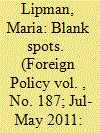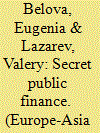| Srl | Item |
| 1 |
ID:
105091


|
|
|
|
|
| Publication |
2011.
|
| Summary/Abstract |
In 1992, barely a year after the collapse of the USSR, three Russian lawyers were granted unprecedented access to the holy of holies -- the minutes of the Politburo, the Soviet Communist Party's highest body. President Boris Yeltsin was anxious to secure his political triumph by seeking to outlaw the Communist Party, and his lawyers were entrusted with using the historical records to prepare his case before the newly formed Constitutional Court.
|
|
|
|
|
|
|
|
|
|
|
|
|
|
|
|
| 2 |
ID:
123414


|
|
|
|
|
| Publication |
2013.
|
| Summary/Abstract |
The darkness was just descending on the campus of the Columbia University in USA. It was in the month of March in 1917. A tall and lanky Bengali Gentleman about 6'2'' high was coming forward with his long steps ahead. If anybody looked him at a glance he could instantly understand how bright he actually was. He was then glittering with his intelligence and sharp eyes. But within moments, a handful of young and robust people from Intelligence Dept.
|
|
|
|
|
|
|
|
|
|
|
|
|
|
|
|
| 3 |
ID:
082096


|
|
|
|
|
| Publication |
2008.
|
| Summary/Abstract |
Patterns of the Soviet Communist Party expenditures, major sources of revenue, and patterns of interregional transfers are analysed with special attention to the party's major donors: the army and large cities. Financial records for the period 1938 - 1965 allow us to study the role of the party in the Soviet institutional design and the relationships between central and regional party organisations. In addition to the selection of cadre, supervision of production, and 'production' of ideology, the party provided alternative channels for the redistribution of state resources. Empirical evidence suggests that the pattern of the distribution of subsidies through party channels was consistent with investing in political support by creating promotion incentives in the party system.
* We are grateful to Bruce Buena de Mesquita, Gerald Dorfman, Michael Ellman, Paul Gregory, Kerry Pannell, Alvin Rabushka, and Dariusz Stola for their interest in this project and many valuable suggestions, two anonymous referees for their helpful comments, and Ann Wood for her keen eye. This article also benefited from the input of participants in Stanford Social Science History workshop, the UCLA Von Gremp workshop, and the Hoover Soviet Economic History workshop. Financial support from the Hoover Institution and the assistance of the Hoover Institution Archives staff are gratefully acknowledged. The authors take full responsibility for any errors in this text.
|
|
|
|
|
|
|
|
|
|
|
|
|
|
|
|